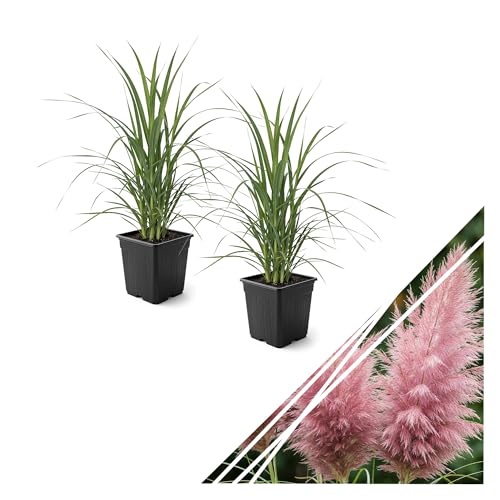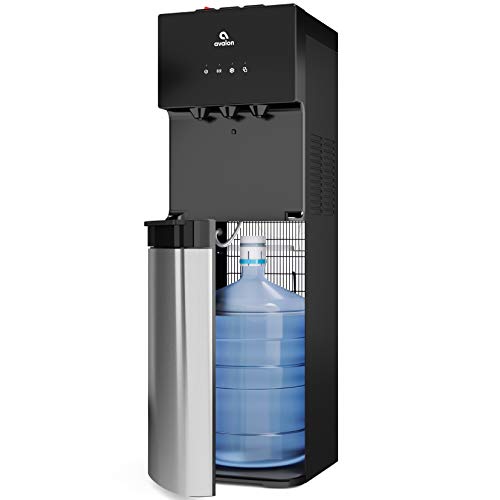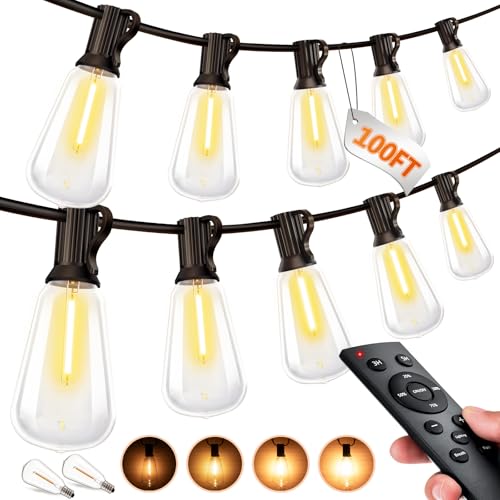Want your home to look great the moment someone pulls up?
These 41 Front of House Landscaping Ideas give quick wins—clean edging, walkway lighting, low-maintenance shrubs, porch planters, drought-tolerant beds, and simple hardscaping.
Each tip is easy to copy and flows into the next, guiding you from front door to curb without guesswork.
Start with the first idea below and keep going—you’ll finish with a clear plan and standout curb appeal.
Let’s get started!
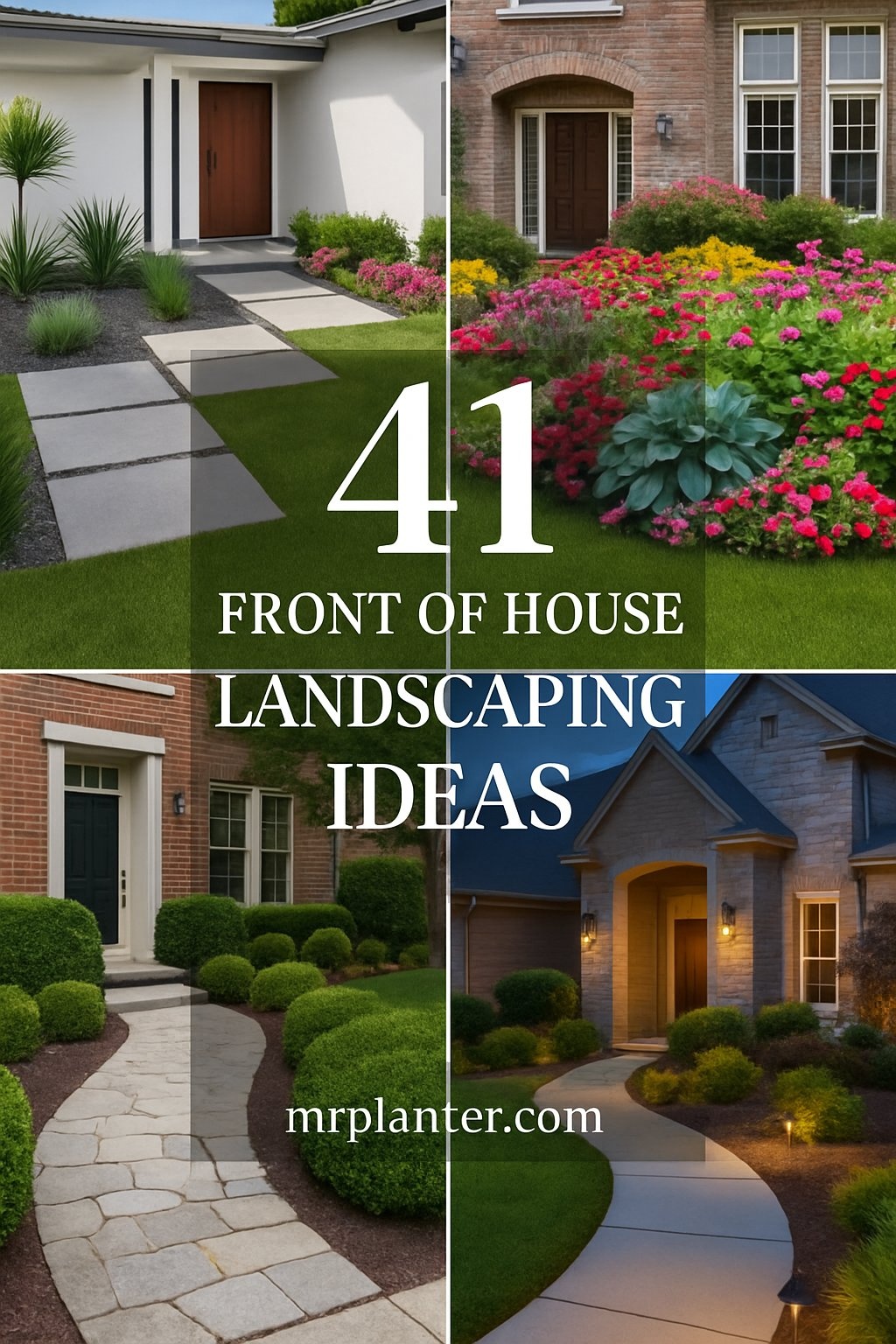
1. Ornamental Grasses — Curved-Walkway Magic
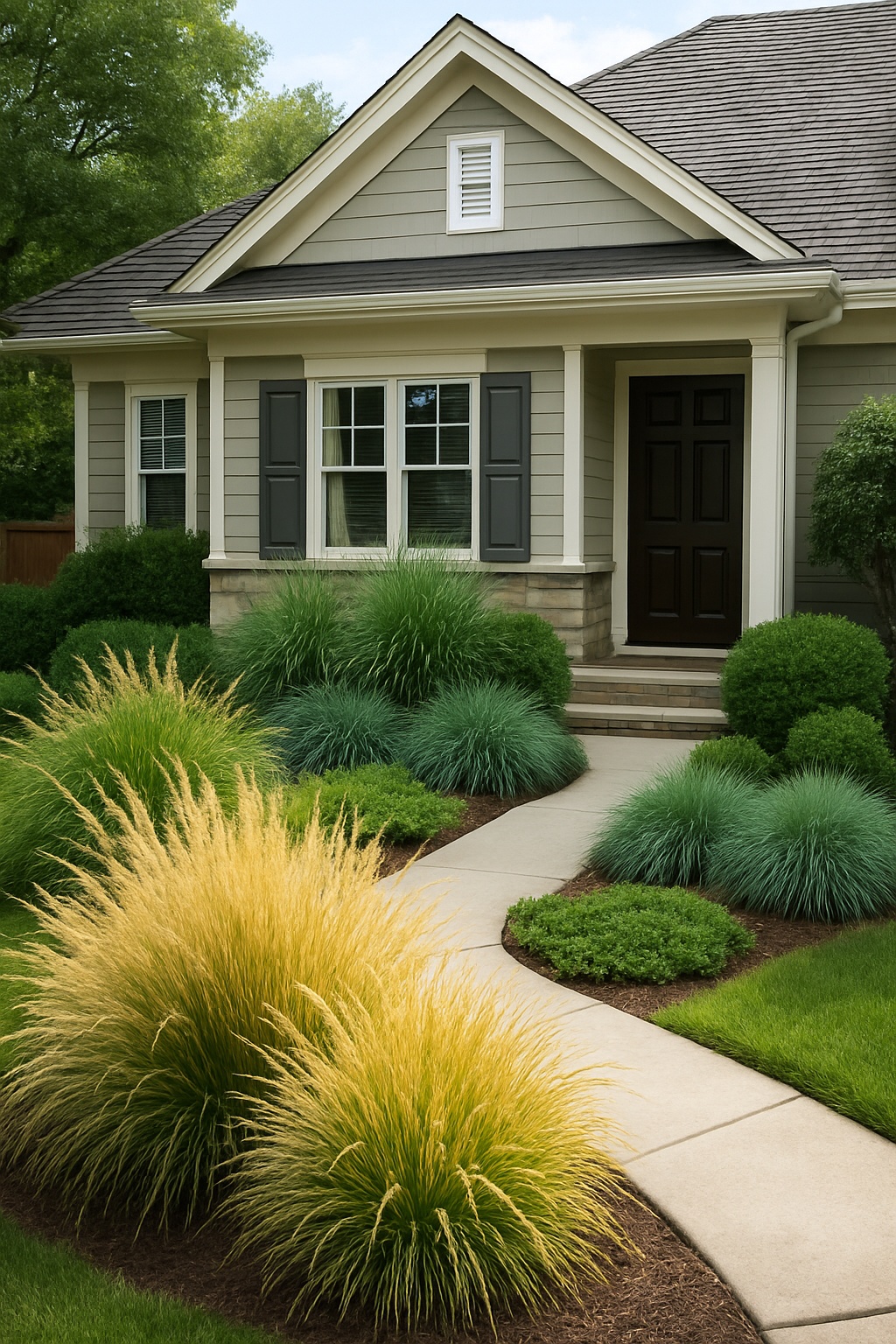
Want instant, low-effort curb appeal? Plant ornamental grasses along your front path. They add soft movement, lush texture, and that “designer” look you see in the photo—golden plumes up front, cool blue-green mounds in the middle, and a neat, mulched edge that keeps everything tidy.
- ORNAMENTAL & DECORATIVE: Adds texture, movement, and elegance to any garden, patio, or landscape design.
- EASY TO GROW: Thrives in full sun and well-drained soil, with minimal maintenance required.
- Pampas grass is ornamental. Fresh green foliage reaches 8 to 12 feet tall, topped by long, thick silky "featherdusters"
- Pampas ornamental grass grows fairly fast making it an ideal choice for filling in large, barren landscapes
Why homeowners love them (and why they’re easy to say yes to):
- Set-it-and-forget-it beauty: Drought-tolerant and low maintenance once established.
- Four-season interest: Feathery plumes in summer/fall; sculptural form in winter.
- Softens hard edges: Perfect along curved walkways and steps—looks welcoming from the street.
- Plays well with others: Pairs beautifully with evergreen mounds and flowering perennials.
Copy this exact look from the image (quick recipe):
- Layer heights: Tall feather reed or switchgrass on the outer curve; mid-height fountain grass inside; low blue fescue or blue oat grass as mounded accents.
- Plant in groups of 3–5 for that full, intentional feel.
- Edge with fresh mulch to make the grasses pop and keep weeds down.
- Let them sway! The gentle movement in the breeze is half the charm.
Easy care: Water regularly the first season, then cut back clumps to 6–8″ in late winter/early spring. Divide every few years if they get crowded.
Expert Tip from MrPlanter: “Choose drought-tolerant varieties to save water and time—they stay beautiful with almost no effort.”
Ready to upgrade your front walk? Grab two or three varieties and repeat them down the curve for a polished, magazine-worthy entrance.
2. Stone Pathways
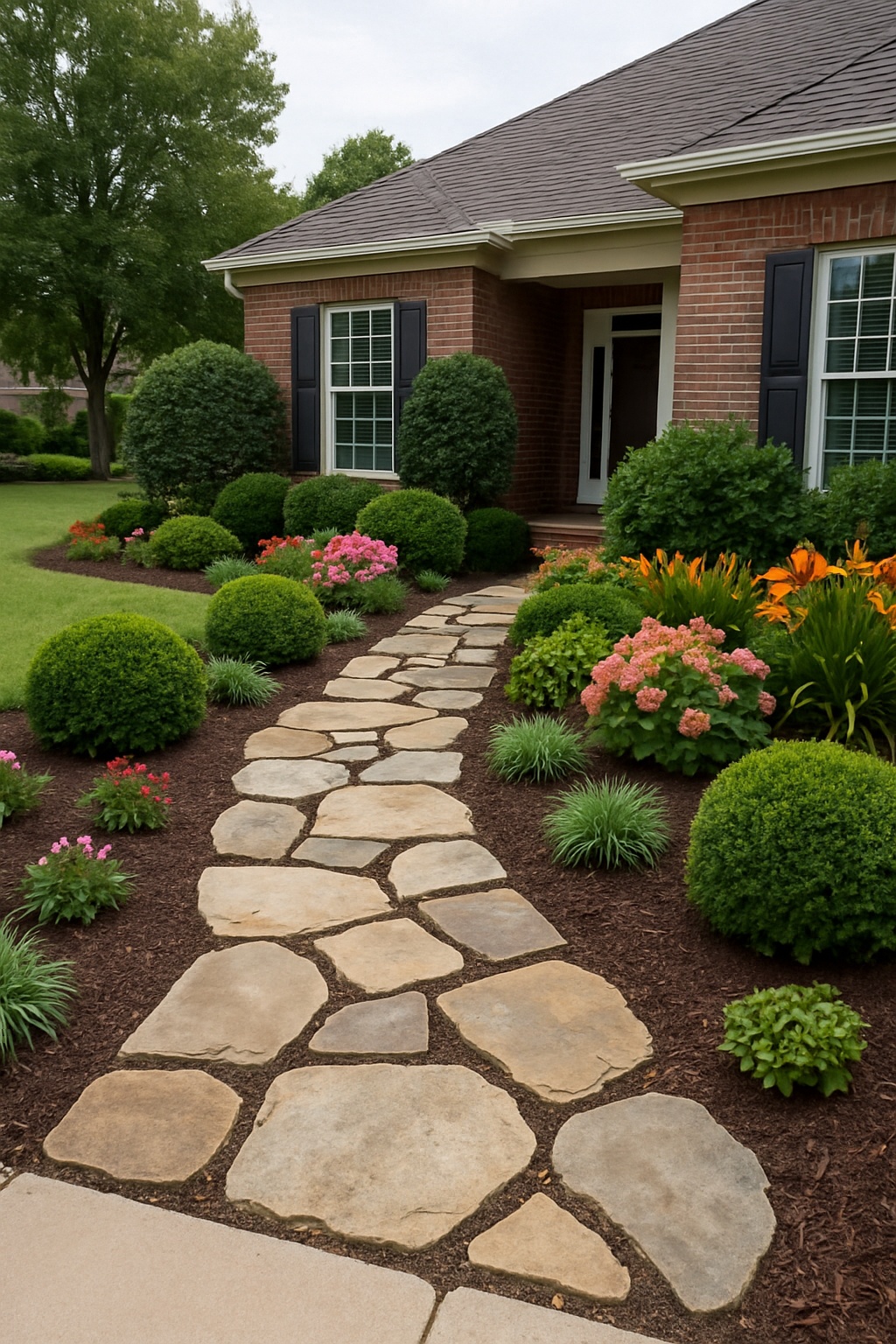
Stone pathways bring a timeless look to your front yard.
- RUBBER STEPPING STONES: Elevate your outdoor space with these lightweight simulated flagstone rubber pavers that offer...
- DURABLE: Made from recycled rubber, these stepping stones outdoor are heavy enough to stay put in place and durable to...
- Lightweight, easy DIY outdoor landscaping solution that’s durable and long-lasting for hassle-free installation and...
- Quick and simple to install, just place it directly over grass or a compacted granular base for an instant upgrade to...
You can create different looks with stone pathways. Try geometric patterns or free-form designs. The variety of shapes and colors allows for creativity.
Adding plants along the edges of the pathway creates a cohesive look. Flowers, small shrubs, or ground cover plants soften the hard edges of the stone.
“Expert Tip from MrPlanter: Choose stones that match your home’s color palette for a more cohesive look. And consider eco-friendly options like permeable pavers to reduce water runoff.”
3. Flower Beds

Flower beds can really brighten up the front of your house.
- Each raised metal garden bed size: 4×2×1ft ,7.14Cu
- Upgraded quality and structure: raised garden beds outdoor are made of Q195 galvanized metal sheet, double-layer...
- Size: Accessories for 2 complete garden beds in one box!!! 72"(L) x 36"(W) x 12"(H), growing area of this garden bed...
- Sturdy Construction: our galvanized raised garden bed is made from thick galvanized steel for superior strength and...
Arrange flowers of varying heights for a layered effect. Place taller plants in the back and shorter ones in the front. Edge the beds with bricks or stones to keep them tidy and add visual interest.
Adding some greenery with ferns and hostas can make the space lush.
Expert Tip from MrPlanter: “Incorporate bulbs for spring and fall interest. Mixing them with your regular plants ensures colorful blooms throughout the year.”
4. Garden Sculptures — Tortoise Planter Spotlight
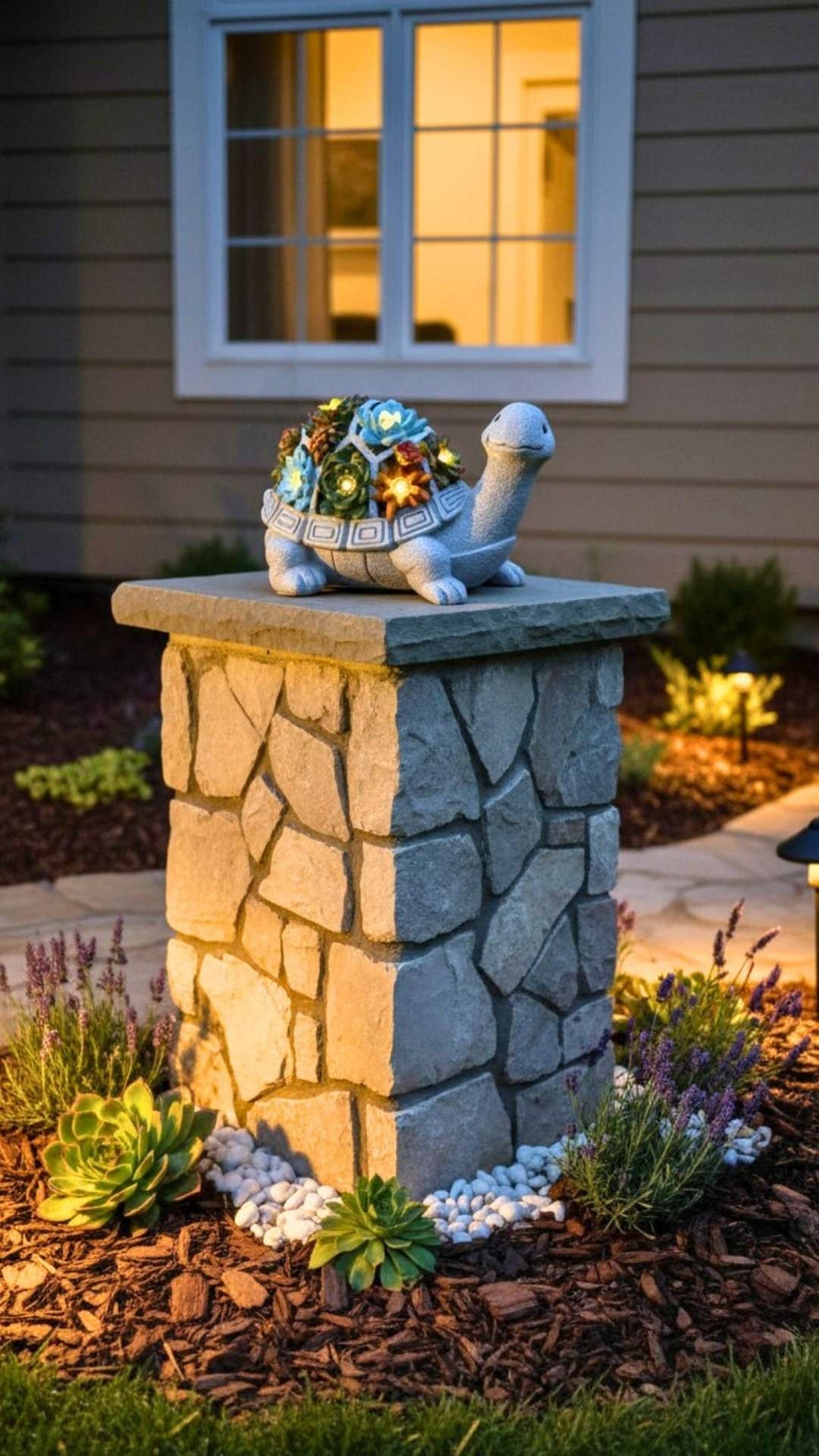
Want your front yard to say a friendlier “hello”? Add a sculpture.
This tortoise planter is a small piece with big charm—cute by day, softly glowing at night—so it instantly boosts curb appeal without a full makeover.
Why neighbors notice (and why it’s an easy buy):
- Instant focal point: A smiling tortoise on a stone pedestal becomes the first thing guests compliment.
- Day-to-night magic: Built-in LEDs (often solar) make the succulents in its shell sparkle at dusk—no wiring required.
- Low-maintenance beauty: Pop in hardy succulents or faux stems and it stays lovely all season.
- Outdoor-ready: Durable, weather-resistant construction stands up to sun, sprinklers, and curious kiddos.
Copy the look from the photo (quick placement tips):
- Set the tortoise on a 24–30″ stone pedestal to give it stature.
- Edge with texture: a neat ring of white pebbles over mulch.
- Plant pairing: lavender for fragrance + rosette succulents for structure.
- Add a small path light nearby to make the shell shimmer after dark.
Pro tip: Mix textures—stone base, smooth sculpture, and soft plants—for a designer finish in minutes.
Stylist’s note: This works for modern, cottage, and family-friendly landscapes alike.
“Mix materials for a unique look—stone, metal, and living plants create instant depth.” – MrPlanter
Ready to give your entry some personality?
👉 Bring home the exact tortoise from the photo: Buy the Tortoise Sculpture →
Here are some more ideas you can explore:
- Thoughtful Christmas Gifts: Comes in a beautifully designed individual box, perfect for Mom; Grandma; Wife; Sister;...
- Automatic Solar Operation: Charges efficiently with 6-8 hours of daylight, activates automatically at dusk, and delivers...
- Rabbit with Solar Lantern: The bronze rabbit statues hold a solar lantern, which casts a warm and welcoming glow. The...
- Automatic Solar Charging:Turn on the switch and place the solar statue in sunlight for 6-8 hours of charging. It will...
- SOLAR POWERED: Features built-in solar panel and LED lights that create a magical illuminated display at night with...
- DIMENSIONS: Measures 10.83 inches tall, 6.5 inches wide, and 4.72 inches deep, perfect for garden or patio display
5. Water Features
Adding water features to your front yard can create a calming atmosphere.
- Decorative Tabletop Fountain: Showcase EnviraScape’s Silver Springs Relaxation Fountain on Display to bring a calming,...
- Convenient Automatic Pump & On/Off Switch: The Illuminated Water Fountain was Designed with a quiet built in submersible...
- THREE TEMPERATURES: Three temperature settings allow you to customize your drinking experience. This dispenser features...
- INNOVATIVE DESIGN: Our sleek stylish stainless steel cabinet will make this water cooler fit right into your home...
Even simple features, like a birdbath or a rain chain, add charm and visual interest to your garden.
Water features can also attract birds and other wildlife, making your garden lively.
Expert Tip from MrPlanter: “Choose low-maintenance water features to avoid extra work and ensure they fit well with your garden’s overall design.”
6. Climbing Vines
Climbing vines can add a charming touch to the front of your house.
- 🍀SIZE:Our ivy garland made from Silk,Plastic,High Quality,Each garland plants 7 FT Long,total 98Ft,Leaves about...
- 🍀SUITABLE OCCASION:The artificial ivy garland can decorate weddings,festivals,safari parties,home decorations,...
- CZ Grain
- CZ Grain Blue Morning Glory Climbing Vine 100 Seeds To Plant Beautiful Flowering Vine
Bougainvillea is another option if you want bright colors. Its fuchsia, crimson, or gold blooms can make your house stand out.
Using a simple metal wire and eye hooks, you can guide vines to grow in the direction you want.
Expert Tip from MrPlanter: “Check your vines regularly during the growing season to make sure they’re growing properly.”
7. Hedge Walls
Hedge walls are perfect if you want more privacy and a green touch to your front yard.
- The faux ivy boxwood roll is 40x120 inches, which can cover 33.5 sqft. The height of the faux ivy boxwood leaves is 2...
- This artificial greenery hedges fence panels Suitable for indoor and outdoor scenes: can be used as wall decor, fence...
- The faux ivy boxwood roll is 120" by 48", which can cover 40 sqft. The height of the faux ivy boxwood leaves is 2",...
- This artificial greenery hedges fence panels Suitable for indoor and outdoor scenes: can be used as wall decor, fence...
These evergreen shrubs can create a natural barrier, keeping your space private and cozy. They also add a beautiful, lush look to your landscape.
“Pick shrubs that are well-suited to your climate to ensure they thrive without too much hassle,” says MrPlanter.
8. Tree Lined Driveways
Tree lined driveways add a dash of elegance to any home. They create a welcoming atmosphere with a touch of nature’s beauty. Popular choices include Honey Locust, Dogwoods, and Lavender for their aesthetic appeal.
Honey Locust trees offer stunning yellow-green canopies. Dogwoods, known for their bright leaves, look great along driveways. Lavender adds color and is drought-tolerant for easy maintenance.
“Choosing trees for your driveway? Look for species that thrive in your climate. Avoid fast-growing trees with aggressive roots,” says MrPlanter.
9. Colorful Perennials
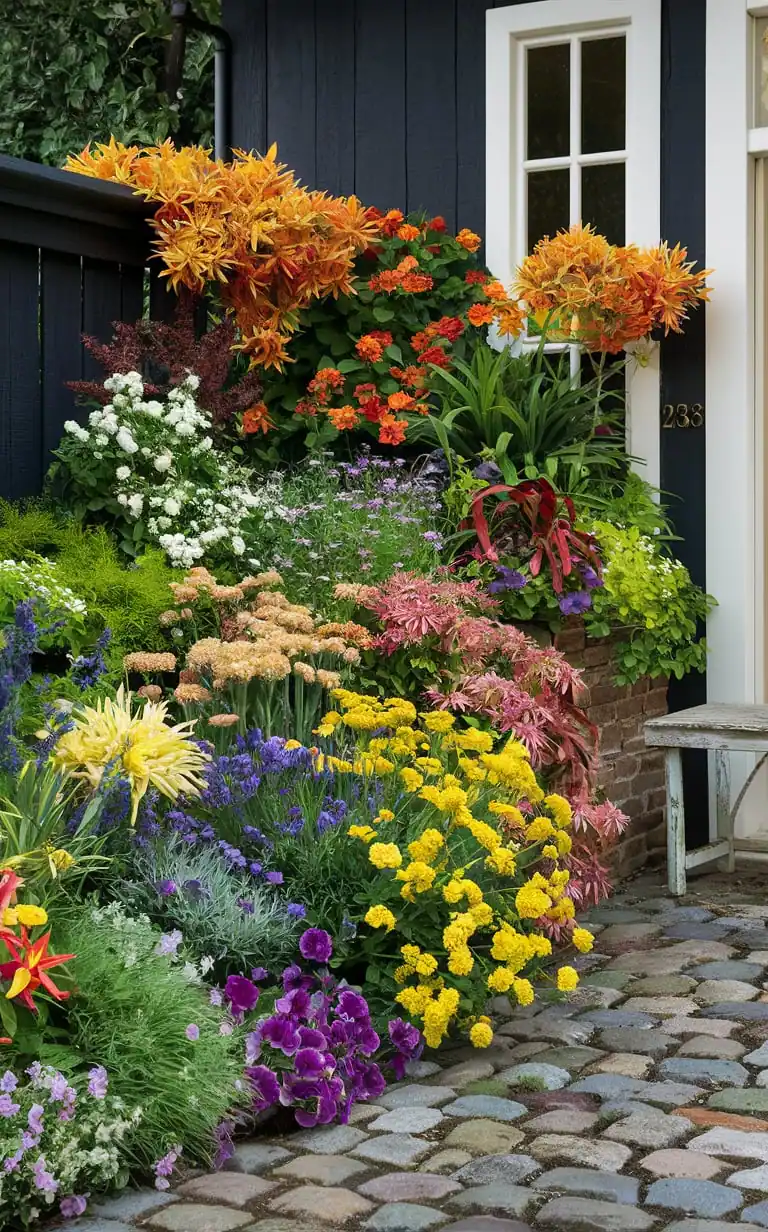
Adding colorful perennials to your front yard is an easy way to create a vibrant and welcoming space. Perennials come back year after year, providing lasting beauty with minimal maintenance.
Consider planting tulips, daisies, or black-eyed Susans for a burst of color. These flowers thrive in different climates and will add charm to your landscape.
Mixing various perennials together can result in a stunning display. Try combining plants with different heights and shades to keep your garden interesting throughout the seasons.
Expert Tip from MrPlanter: “Group your perennials based on their sunlight needs for the best growth results.”
10. Seasonal Planters
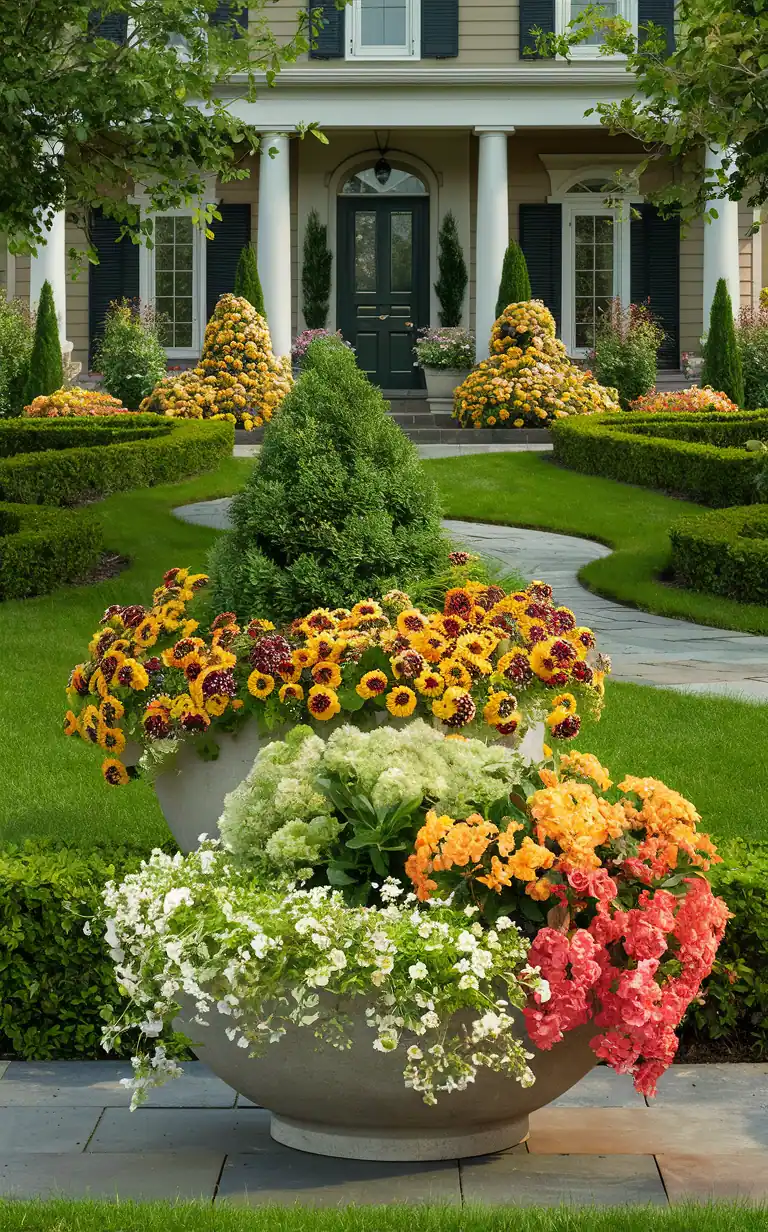
Seasonal planters are a great way to keep your front yard looking fresh all year round. In spring, fill your pots with tulips, daffodils, and pansies.
For summer, choose vibrant flowers like marigolds, petunias, and geraniums. Autumn can bring in mums, asters, and ornamental cabbages.
Winter doesn’t have to be dull. Use evergreen branches, holly, and pinecones for a festive touch.
“Remember to switch plants as the seasons change to keep everything healthy and looking its best!” – MrPlanter
11. Bamboo Fencing
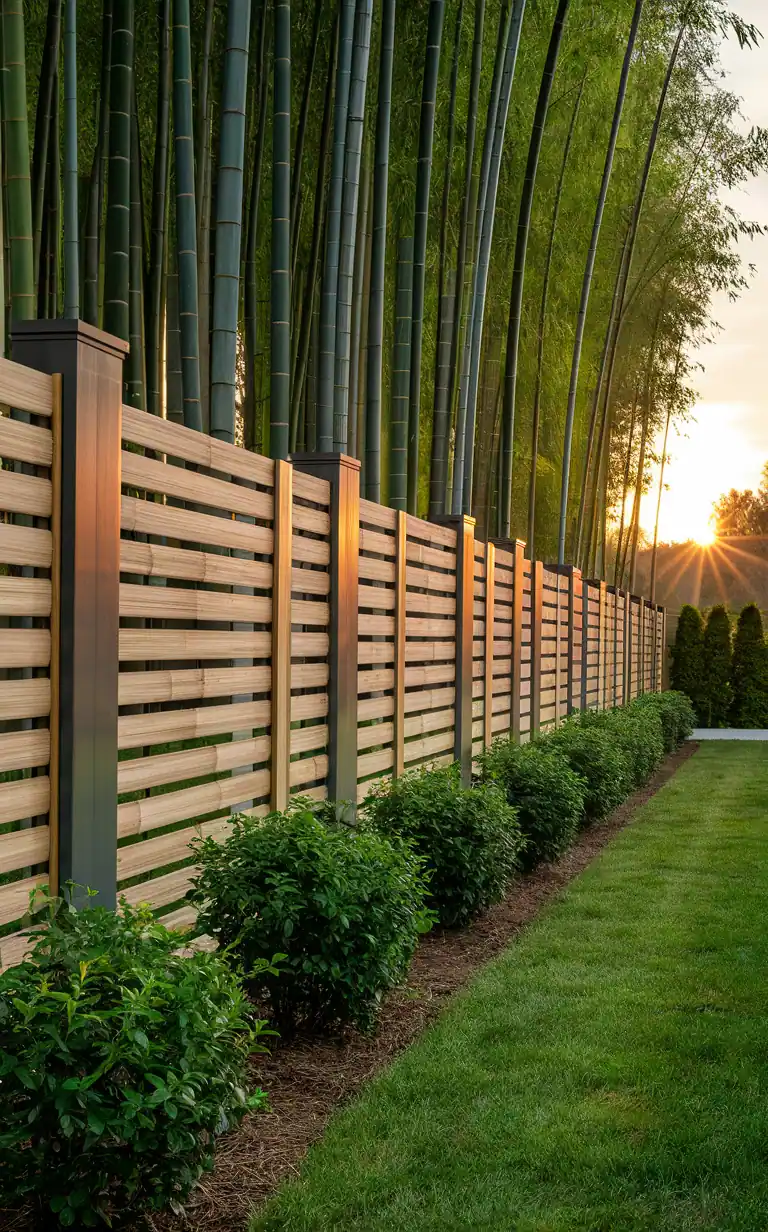
Bamboo fencing is a great way to add a natural and stylish look to your front yard. It is eco-friendly and can be used in many designs.
You can combine bamboo with other materials, like metal or wood, for a sturdy and modern feel. Bamboo can also be used in a variety of styles, from vertical slats to lattice designs.
Expert Tip from MrPlanter: “Seal your bamboo fence every year to protect it from weather damage and keep it looking fresh.”
12. Outdoor Lighting

Good lighting is a key element of your front yard.
- [Remote Control & Dimmable] - MGVIH Outdoor String Lights come with remote controls that allow you to adjust the...
- [100FT Patio String Lights] - 100 FT LED string lights for outdoor use, comprising 37Pcs ST38 bulbs and 2 spare bulbs;...
- 【Remote Control & 3 Lighting Modes】:Each solar motion sensor light is equipped with wireless remote control.You can...
- 【Super Bright Solar Motion Sensor Lights】:The solar outdoor lights equipped with 210 super bright LED beads, produce...
Path lights along walkways or around garden beds help lead the way and prevent trips. Use solar or battery-powered options if outlets are not nearby.
Wall sconces near the entrance create a warm, inviting glow. Downlighting around water features adds a natural look.
Expert Tip from MrPlanter: “Try placing string lights in trees for a magical touch, perfect for evening gatherings.”
13. Rock Gardens
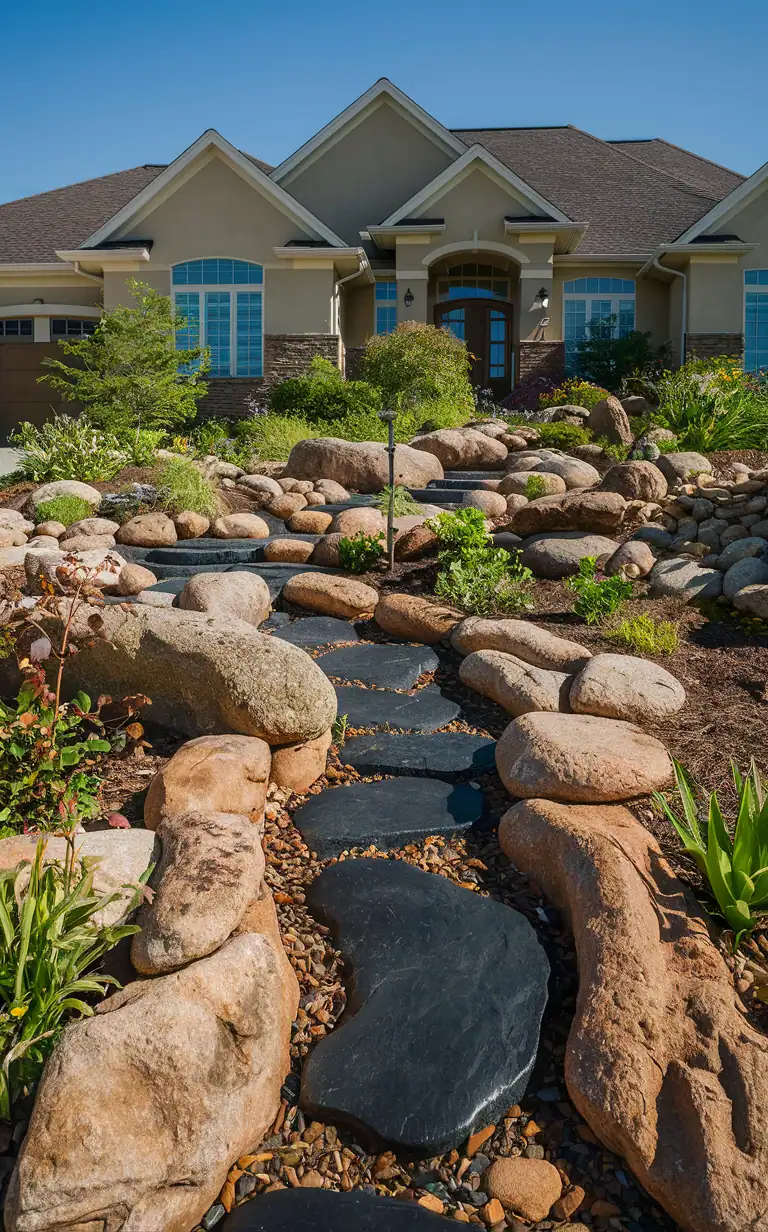
Rock gardens can transform your front yard into a stunning landscape. Use a mix of large stones and gravel to add texture and depth.
Place colorful succulents between rocks to create vibrant contrasts. Add hardy grasses or small flowering plants to soften the look.
Small boulders can serve as focal points, breaking up the space and adding interest.
“Choose rocks of varying sizes to create a natural look,” says MrPlanter.
14. Front Yard Patios

Adding a patio to your front yard can create a welcoming space for guests and a cozy spot for you to relax. Consider using materials like pea gravel, concrete pavers, or bricks for a stylish foundation.
Enhance the area with comfortable seating, a bistro set, or even a small fire pit to make it inviting. Surround the patio with plants, flowers, and maybe a few decorative stones to give it a charming look.
“Choosing weather-resistant furniture is key to maintaining your front yard patio year-round,” says MrPlanter.
15. Edible Gardens
Edible gardens not only provide fresh veggies and herbs but also add beauty to your front yard. Mix edible plants with flowers like lavender or bee balm to attract pollinators.
Start by adding compost to your soil to ensure your plants thrive. Plant in clusters to create visual interest. Raised beds can help you organize and maintain your garden easily.
Expert Tip: “Enrich your soil with compost at the start of every season,” says MrPlanter. “Healthy soil is key to a productive edible garden.”
16. Mossy Accents
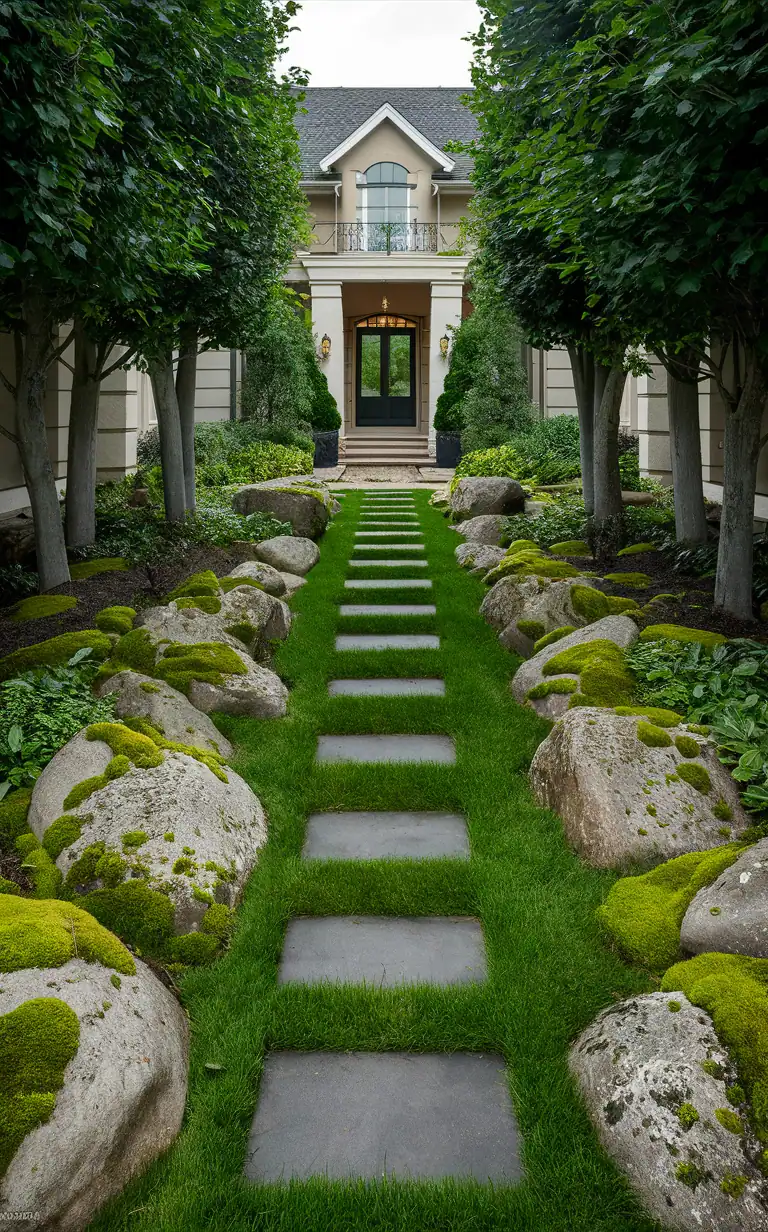
Adding moss to your front yard gives it a unique, natural look. It’s low-maintenance and thrives in shady spots, making it perfect for areas under trees and along stone pathways.
Moss rocks can line pathways, creating a soft, green touch. They look especially good with wood or stone features.
You could also use moss as ground cover. It’s a great way to fill in empty spaces without much fuss.
“Moss can bring a lush feel to your yard with minimal upkeep,” says MrPlanter. “Just keep the area moist and enjoy the greenery!”
17. Topiary Trees
Topiary trees can add a touch of elegance and creativity to your front yard. These sculpted plants come in various shapes like cones, spheres, and spirals.
Place them along pathways or near the entrance to create a welcoming look. They look striking when paired with other plants or decorative elements like rocks and lamps.
Topiary trees can be low-maintenance with the right care, needing only regular trimming to keep their shape.
Expert Tip from MrPlanter: “Choose evergreen varieties for year-round greenery and structure in your landscape.”
18. Wildflower Meadows
Wildflower meadows can make your front yard look vibrant. They attract bees and butterflies, adding life to your garden.
Start by planning your meadow. Check the sunlight and soil type. Choose wildflowers that fit these conditions.
Plants like purple wild marjoram and red campion can add height and color. Balance them with green ground covers.
“Expert Tip: Plan your wildflower meadow with a mix of annuals and perennials for constant blooms,” says MrPlanter.
19. Decorative Bridges
Adding a decorative bridge to your front yard can create a charming focal point. It could be a classic wooden arch bridge over a tiny pond or a more modern design with sleek lines.
Choose materials that match your garden’s style, like stone, wood, or wrought iron.
“Expert Tip from MrPlanter: “Position the bridge where it can be seen from the road or walkway for maximum impact.”
20. Natural Stone Edging
Using natural stones for your landscape edging adds a rustic, organic feel to your yard. These stones come in different shapes, colors, and sizes, making each arrangement unique.
Natural stone edging is great for defining garden beds, pathways, and other areas. It’s low maintenance and blends seamlessly with plants and other natural elements in your garden.
Expert Tip from MrPlanter: “Choose stones that complement the color of your house and garden for a cohesive look,” says MrPlanter.
21. Window Flower Boxes
Window flower boxes add charm and life to the outside of your home. They are perfect for growing a variety of plants, from colorful flowers to lush greens.
For a balanced look, mix plants with different heights and textures. For example, plant big Geraniums in the center and add smaller, trailing plants like Verbena at the edges.
Make sure your window boxes get enough sunlight. Flowers like Angelonia thrive in full sun, providing a bright spot on your window ledge.
Expert Tip from MrPlanter: “Use a good quality potting mix and ensure your window boxes have proper drainage. This keeps your plants healthy and vibrant.”
22. Bird Baths
Bird baths add beauty and attract wildlife to your front yard. They come in various designs, from simple bowls to intricate sculptures. Choose one that fits your garden’s style.
Add a ground-level bird bath to provide easy access for birds and other small animals. It can be a fun way to watch nature up close.
Consider adding stones or marbles to the bird bath. It makes it easier for bees and butterflies to land and drink water.
Expert Tip: “Place your bird bath near bushes or trees for birds to quickly find shelter if needed,” says MrPlanter.
23. Tree Swings
Adding a tree swing to your front yard can bring a touch of classic charm. Wooden rope swings are a great choice for both kids and adults. They are simple to install and need only strong ropes, a sturdy branch, and a wooden seat.
Consider making a bed swing for a cozy and relaxing spot. Use recycled wooden pallets, rope, and cushions. This type of swing can be a bit more involved to build but offers a comfortable place to enjoy your garden.
“Expert Tip from MrPlanter: Always check that the branch you use is strong and healthy to support the swing safely.”
24. Lavender Borders
Lavender borders are a beautiful way to add color and fragrance to your front yard. These plants create a neat and tidy appearance along walkways or driveways.
Lavender is low-maintenance, drought-tolerant, and it blooms in lovely shades of purple. It attracts bees and butterflies, adding life to your garden.
To make a lasting impression, plant lavender in straight rows. This creates a clean and orderly look that’s both inviting and elegant.
“Lavender loves full sun and well-drained soil. It’s great for adding both color and scent to your landscape.” — MrPlanter
25. Drought-Tolerant Plants
Consider plants like lavender, which holds up well in dry conditions. It has beautiful purple flowers and a lovely scent.
Succulents are another great pick. They store water in their leaves, making them perfect for hot, dry climates.
Using silver or gray foliage, like lamb’s ear or Russian sage, can add both color and texture to your garden.
Expert Tip from MrPlanter: “Incorporate a layer of mulch around these plants to help reduce water loss and keep weeds at bay.”
26. Garden Benches
Garden benches add charm and functionality to your front yard.
- 🌞【Sturdy and Rust-Resistant】The Garden Bench is powder coated with rust-resistant finish, super smooth. The Park...
- 🌞【Easy to Assemble the Metal Bench】 Specific manual and complete accessories of the Garden Bench greatly help you...
- 【Sturdy and Safe】This garden bench is made of cast iron backrest and metal frame, which is stable and sturdy for...
- 【Elegant Floral Pattern】Crafted with floral pattern and wave edge of backrest, the simple but elegant look of this...
Consider placing your garden bench in a cozy corner or near flower beds. This creates a relaxing spot to enjoy your garden’s beauty.
“Use weather-resistant materials for long-lasting benches,” says MrPlanter. “They require less maintenance and stay looking good year-round.”
27. Raised Garden Beds
Raised garden beds make your yard look neat and organized. They also keep soil in place and help with drainage.
You can use a variety of materials for the beds, like wood, stone, or bricks. Each gives a different look and feel to your yard.
Raised beds make it easy to control soil quality and reduce pests.
“Raised beds are great for small spaces. They allow you to grow more in less space.” — MrPlanter
28. Vertical Gardens
Vertical gardens save space and let you grow more plants. You can use walls, fences, or even build special frames. Imagine adding a green touch to your home’s front entrance.
Materials like wooden pallets and wire mesh panels are great for making vertical gardens. They give your garden a neat look and offer lots of spots for different plants.
Use them to grow flowers, herbs, or even vegetables like strawberries.
Expert Tip from MrPlanter: “Position your vertical garden where it gets the right amount of sunlight for the plants you choose.”
29. Fruit Bearing Trees
Fruit-bearing trees are a great addition to your front yard. They not only provide delicious fruits but also add charm to your landscape.
Consider adding a fruity espalier tree to save space and still enjoy the benefits. You can get these ornamental trees in different designs from places like River Road Farms.
Expert Tip from MrPlanter: “Make sure to plant fruit trees in a spot that gets full sun for the best fruit production.”
30. Garden Trellises
Garden trellises are a great way to add some charm to your front yard. They can support climbing plants like roses and flowering vines.
A trellis can be made from materials like wood, metal, or bamboo. You can pick one that matches your home’s style.
You can place a trellis near your porch, windows, or create an archway.
Expert Tip: “Choose materials that weather well in your climate and give your plants the right support,” says MrPlanter.
31. Butterfly Gardens
A butterfly garden can add vibrant life to your front yard. Choose a sunny spot that gets at least 6 hours of light daily. Plants like asters, purple coneflowers, and milkweed attract butterflies.
Include both nectar flowers for adult butterflies and leafy plants like parsley for caterpillars. Adding rocks or pavement can help warm up the space.
Expert Tip from MrPlanter: “Make sure you have a mix of plants that bloom at different times to keep butterflies coming throughout the season.”
32. Fragrant Hedges
Plant fragrant hedges to add beauty and amazing scents to your front yard. Consider shrubs like lavender, wintersweet, or gardenia. These plants not only look great, but they also smell wonderful.
Lavender is easy to grow and has a pleasant, calming fragrance. Gardenias have glossy leaves and sweet-smelling white flowers.
Expert Tip from MrPlanter: “Trim your fragrant hedges regularly to maintain their shape and boost flower production.”
33. Paver Walkways
Paver walkways can transform the look of your front yard. They are durable and come in a variety of styles, shapes, and colors.
You can choose designs that match your home’s aesthetic, whether modern or traditional. They make any entrance more inviting.
“Choose materials that complement your home. It’s important for a harmonious look.”—MrPlanter
34. Porch Swing with Cushions
A porch swing with cushions can transform your front porch into a welcoming hangout spot. Choose a swing style that matches your home’s design, like a farmhouse wood swing or a sleek wicker hanging swing.
Add colorful or patterned cushions to make it even cozier. This not only boosts comfort but adds a splash of personality to your entryway.
“For a charming look, use pillows and cushions with floral prints or bold colors,” says MrPlanter.
35. Mulch Beds
Mulch beds are an easy way to add color and texture to your front yard.
- 100% Organic & Peat-Free: Our organix mulch mix is 100% organic & peat-free. Peat is one of Mother Nature’s most...
- Intended for use in Mulch Soil: Our unique soil blend is ideal for nurturing herbs, vegetables, and fruits planted in a...
- Grows bigger plants with more blooms and fruits!
- Won't harden and reject water like peat soils
Choose mulch color that complements your home’s exterior. Dark brown or black mulch is popular for contrast.
One great thing about mulch is its low maintenance. Just refresh it once or twice a year. It’s perfect if you want a neat and tidy garden without too much effort.
Expert Tip from MrPlanter: “Mix mulch types for a layered look and better moisture control.”
36. Bistro Tables
Adding a bistro table to your front yard can create a cozy spot for morning coffee or evening chats. These small tables fit well in most spaces, even tight areas.
You can choose from various materials like metal, wood, or resin. Each offers a different vibe, so pick one that matches your home’s style.
“Choose durable materials for long-lasting use,” says MrPlanter. “Consider shade options to keep the area comfortable.”
37. Ivy Covered Walls
Ivy-covered walls add a charming and classic touch to your home’s exterior. The green vines create a natural, timeless look that blends well with various landscapes.
Planting ivy is simple. Choose a variety that suits your climate and make sure it gets enough sunlight.
“Make sure to trim the ivy regularly to prevent it from taking over unwanted areas,” notes MrPlanter.
38. Mixed Flower Borders
Mixed flower borders can bring a vibrant and colorful touch to your front yard.
Use a mix of perennials, annuals, and bulbs to ensure that your garden stays lively throughout the year.
Try combining different heights and colors for an eye-catching display.
“Expert Tip: MrPlanter suggests placing taller plants at the back and shorter ones at the front for a layered look.“
39. Native Plants
Using native plants in your front yard can create a beautiful and sustainable landscape. Native plants are well adapted to your local climate and soil, making them easier to take care of.
You’ll support local wildlife like birds and beneficial insects by planting natives. These plants help create a balanced ecosystem in your yard.
“Expert Tip: Native plants require less water and fertilizer than non-native plants. This can save you time and money in the long run.” – MrPlanter
40. Succulent Arrangements
Succulents are great for front yard landscaping because they need little water and come in many colors and shapes.
You can arrange them between rocks to create a natural look. Mixing tall plants like agave with small ones like sedum can add depth to your garden.
Group different species to play with colors and texture.
Expert Tip from MrPlanter: “Don’t overcrowd them. Succulents need space to grow and show off their beauty.”
41. Mulberry Trees
Mulberry trees can be a great choice for your front yard. They prefer at least 6 to 8 hours of sunlight and well-draining, loamy soil.
These trees can add a unique look with their broad leaves and spreading branches. White mulberries are banned in some regions, so check your local guidelines before planting.
Expert Tip from MrPlanter: “Mulberry trees thrive in slightly acidic to neutral soil, with a pH of 6.0 to 7.0.”
Design Principles for Front of House Landscaping
Getting your front yard to look just right involves selecting plants that suit your climate and balancing hardscape features like walkways with softscape elements such as lawns and flower beds.
Choosing the Right Plants
First, think about your climate. Pick plants that thrive in your area’s weather. Native plants usually do well because they’re adapted to local conditions. They also need less water and maintenance.
Next, consider the color and height of your plants. Mix tall and short plants to create depth. Use colorful flowers to add visual interest. Group plants with similar water and sunlight needs together.
Finally, plan for all seasons. Choose a mix of plants that will give your yard color throughout the year. Evergreens, for example, keep your yard looking good even in winter.
Balancing Hardscape and Softscape
A great front yard combines hard surfaces and soft greenery. Hardscape elements include things like paths, walls, and patios. Softscape elements involve plants, grass, and soil.
Start with paths and walkways. Make sure they’re wide enough for easy walking and consider using materials like stone or brick. They add structure to your yard and guide visitors to your front door.
Then, add softscape elements. Use grass and flower beds to soften the look of your hardscape features. Try adding a curved flower bed by the driveway to make it more inviting.
Don’t forget about focal points. Hardscape features like a water fountain or a large tree can draw the eye and create a strong visual impact. Add plants around these features to enhance their look.
Mixing hardscape and softscape elements in balance creates a front yard that’s both functional and beautiful.
Maintaining Your Front Yard Landscape
Maintaining your front yard landscape involves consistent seasonal care and proper watering techniques to ensure your plants thrive and your yard remains beautiful year-round.
Seasonal Care Tips
Each season brings its own set of tasks to keep your front yard looking its best. In the spring, focus on cleaning up winter debris, pruning dead branches, and planting new perennials.
During summer, keep an eye out for pests and diseases that can harm your plants. Regularly mow your lawn, trim bushes, and deadhead flowers to encourage new blooms.
Fall is the time to rake leaves, aerate your soil, and add mulch to beds to protect plants over the winter. Winter involves wrapping delicate plants and ensuring your irrigation system is winterized to prevent damage.
By tackling specific tasks each season, you can maintain a vibrant and healthy front yard landscape.
Watering and Irrigation Systems
Proper watering is crucial for plant health. Installing an irrigation system can save time and water. Drip irrigation is excellent for flower beds, delivering water directly to roots. Sprinkler systems are ideal for lawns, but ensure they’re adjusted to avoid overwatering.
Watering early in the morning reduces evaporation and helps plants absorb moisture before the heat of the day. During hot months, you may need to water more frequently.
Check the soil moisture frequently. Use a simple soil moisture meter, which can guide you on when to water. Mulching helps retain soil moisture and can reduce the frequency of watering.
Maintaining a well-balanced irrigation system keeps your landscape lush and reduces water waste.
